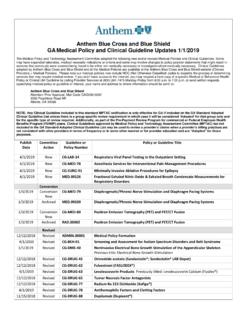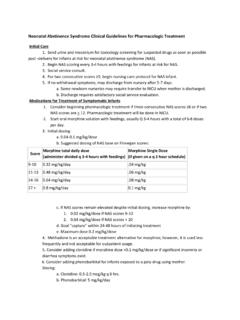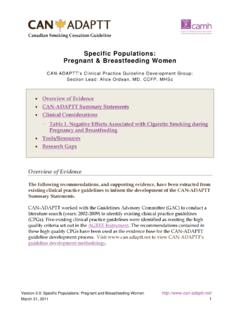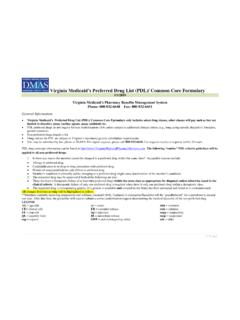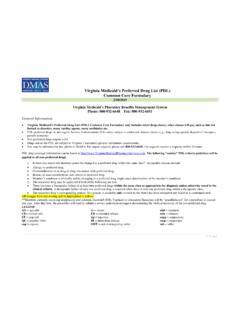Transcription of Standardized Protocol Neonatal care support, including ...
1 Standardized Protocol Available resources Neonatal care support, including nutrition Developmental support Pharmacological support Identification of infants at risk from maternal exposure Information from obstetric provider(s). History of opioid use disorder/substance use disorder and/or treatment Screening questionnaires ( , 4Ps). Maternal biological testing results PDMP. Non-pharmacological management strategies: Begin with risk factors or symptoms. Eat Sleep Console (ESC). Breastfeeding/breast milk Rooming in McKnight S, Coo H, Davies G, Holmes B, Newman A, Newton L, et al.
2 Rooming-in for Infants at Risk of Neonatal Abstinence Syndrome. Am J Perinatol. 2015 Nov 20;. Assessment of symptoms: Consider options for assuring inter-rater reliability. Finnegan Lipsitz WAT-1. Pharmacological strategies (Required: Guidelines for initiation, adjusting dose, and weaning). Morphine Finnegan score: 8 x3; 12 x2. Initiation 8-10, mg/kg/dose q3h 11-13, mg/kg/dose q3h 14-16, mg/kg/dose q3h 17, mg/kg/dose q3h Adjusting dose Goal: control symptoms with 24-48 hours 9-10, increase by mg/kg/dose q3h >10, increase by mg/kg/dose q3h Maximum dose mg/kg/dose q3h Decreasing the dose if overshooting the mark Weaning After withdrawal controlled for 24-48 hours Wean by 10% of max dose q48 hrs Can wean daily if stable and <9, but consider weaning by 5%.
3 In 24 hr period, if 3 scores >8-10, or 2 scores >12, consider increasing dose back to last stable dose and holding at that dose x24-48 hours When total dose is < mg/kg/dose q3h, consider weaning q 24 hrs Clonidine Initiation Consider clonidine if morphine > mg/kg/dose, or if significant insomnia or diarrhea ( mcg/kg q6h). Weaning Wean clonidine over 2-3 d after morphine discontinued Phenobarbital Initiation Consider phenobarbital with poly-drug exposure (5mg/kg/day). Weaning Discontinue phenobarbital after other meds discontinued.
4 Methadone Brown MS, Hayes MJ, Thornton LM. Methadone versus morphine for treatment of Neonatal abstinence syndrome: A prospective randomized clinical trial. J Perinatol. 2015. Apr;35(4):278 83. Buprenorphine Hall ES, Rice WR, Folger AT, Wexelblatt SL. Comparison of Neonatal Abstinence Syndrome Treatment with Sublingual Buprenorphine versus Conventional Opioids. Am J Perinatol. 2017 Nov 7;. Kraft WK, Adeniyi-Jones SC, Chervoneva I, Greenspan JS, Abatemarco D, Kaltenbach K, et al. Buprenorphine for the Treatment of the Neonatal Abstinence Syndrome.
5 N Engl J Med. 2017 May 4;. Discharge Feedings Medications Information (NAS and resources). Follow-up Pediatric care Developmental follow-up Therapy(ies). Q:\Perinatal quality collaborative\ \NAS change package\Standardiz
